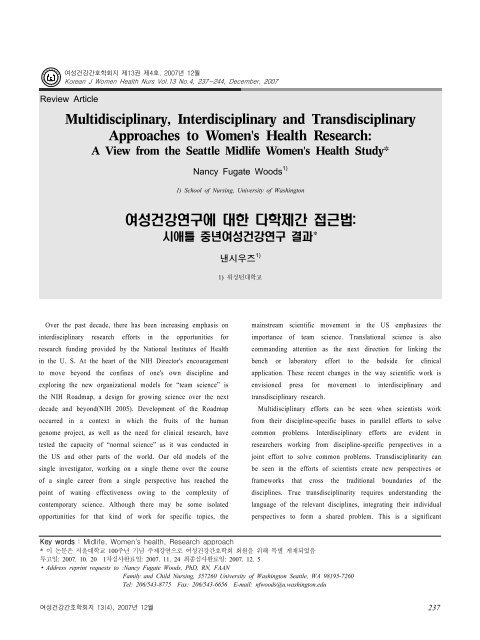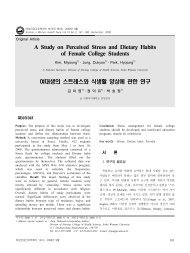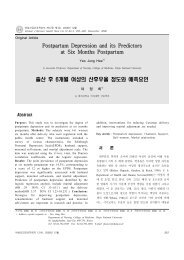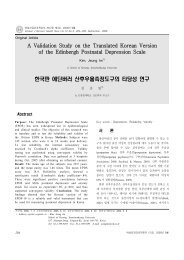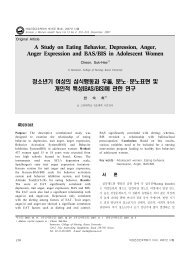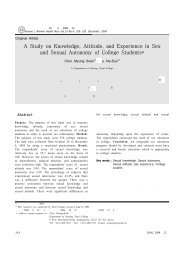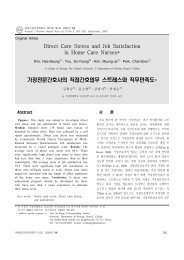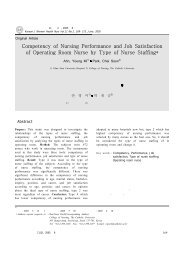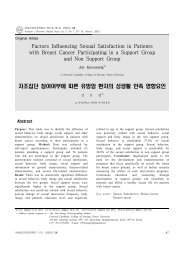Multidisciplinary, Interdisciplinary and Transdisciplinary Approaches ...
Multidisciplinary, Interdisciplinary and Transdisciplinary Approaches ...
Multidisciplinary, Interdisciplinary and Transdisciplinary Approaches ...
Create successful ePaper yourself
Turn your PDF publications into a flip-book with our unique Google optimized e-Paper software.
Nancy Fugate Woodseffort because how one names the problem may drive how itis studied. Coming to an underst<strong>and</strong>ing of what the problem is<strong>and</strong> carrying out the research to solve the problem jointly is ahallmark of transdiciplinarity(Nowotny 2005). There are fewmodels of transdisciplinarity available to guide our efforts <strong>and</strong>that is not surprising, given the ways in which most of ushave been educated. Moreover, Mitchell(2005) asks whether itmatters to have multidisciplinary, interdisciplinary ortransdisciplinary work as long as the collaboration broadens thescope of the work, yields new perspectives <strong>and</strong> insights <strong>and</strong>gives birth to new hybrid disciplines that may offer moresophisticated analytic approaches.Is this an important question within the discipline ofnursing? In the US, the importance of this question lies in ourapproaches to supporting science through federal grants as wellas developing the knowledge for practice. Given that mostnursing services are delivered in a system in which manydisciplines participate, it is significant that at the least weconduct research that shares a focus on a common problemfrom many perspectives – interdisciplinary efforts – instead ofworking in parallel. Perhaps transdisciplinary efforts are theevolutionary consequence once interdisciplinary relationships arewell established. Could we forge a new field of women'shealth? Or will we merely reproduce what we already knowfrom our own disciplinary perspectives?Of importance is that nursing, as a discipline, is poised wellfor interdisciplinary if not transdisciplinary work. The originsof scientific effort in the US have their roots in a variety ofacademic disciplines <strong>and</strong> these roots have shaped the evolutionof our contemporary nursing science. Some history about theevolution of nursing science in the US may help illustrate howdeeply we are rooted in other disciplines. As nursing programsentered universities from hospitals in the 1950s, there werefew opportunities for nursing faculty to pursue doctoral studies.At the time, the most common pathways toward the doctoratewere through programs in Education, either the Ed D or thePhD. The second generation of nurses to earn doctorates in theUS studied in related disciplines. During the late 1960s <strong>and</strong>1970s many nurses earned the PhD in physiology, publichealth, sociology, psychology, <strong>and</strong> anthropology. During the1970s many nurses studying for the PhD pursued the NurseScientist Programs funded by the Division of Nursing in whatis now HRSA. These nurses completed a minor sequence ofcourses in nursing as well as the discipline in which theyearned their degrees(Stevenson <strong>and</strong> Woods, 1986). Thesegraduates contributed significantly to the development of thenew doctoral programs in nursing which appeared in the late1970s <strong>and</strong> the 1980s <strong>and</strong> continue to develop in the US evenin the 21st century as the need for nursing educators burgeons.The inherent interdiscipinarity of our faculty, given theireducational pathways, has enriched doctoral study in the US<strong>and</strong>, I believe that because of this, we are poised for the nextstage of our scientific development. With these definitions inmind, <strong>and</strong> with that history lesson about the development ofthe US br<strong>and</strong> of nursing science introduced, let me now turnto the central aims of this paper which are to:• Describe the development of an interdisciplinary women'shealth research program in nursing• Illustrate the necessity of interdisciplinarity in both vision<strong>and</strong> collaboration efforts• Trace progress in the research program to interdisciplinaryinvolvement• Discuss impact of interdisciplinary collaboration on theresearch outcomes as the results are translated to practice.• Imagine the future possibilities for this work in a trulytransdisciplinary effort.Background: Development of The Seattle MidlifeWomen's Health Study as an <strong>Interdisciplinary</strong>Research ProgramIn 2006, after 15 years in the field, Dr. Ellen Mitchell <strong>and</strong>I ceased data collection for a study of midlife women's healthas they traversed the menopausal transition. The experiences ofconducting that study <strong>and</strong> the study outcomes represent a trulyinterdisciplinary effort <strong>and</strong> one in which there wasinterprofessional collaboration. In the spirit of our focus oninterdisciplinarity, I will use our experiences with the SeattleMidlife Women's Health Study as an exemplar because it isthe one I know best.In 1989, two years before the US Women's Health ResearchAgenda was formulated <strong>and</strong> published by the NationalInstitutes of Health, the UW School of Nursing won a centergrant award from the National Institute of Nursing Research toestablish a Center for Women's Health Research at the U ofW. The original aims of the center were to promote researchabout women's health across the lifespan, with a particularfocus on midlife <strong>and</strong> older women(Woods <strong>and</strong> Shaver, 1992).238 여성건강간호학회지 13(4), 2007년 12월
<strong>Multidisciplinary</strong>, <strong>Interdisciplinary</strong> <strong>and</strong> <strong>Transdisciplinary</strong> <strong>Approaches</strong> to Women's Health ResearchOne of the two large studies that was a component of theCenter was titled “Midlife Women: Health <strong>and</strong> HealthSeeking-Behavior.” The focus of that study was largelydescriptive, <strong>and</strong> included testing a model that accounted forwomen's health <strong>and</strong> health-seeking behavior as measured byseveral indicators. The major concepts organizing this studyincluded: menopausal transition, health <strong>and</strong> health status, healthbehaviors <strong>and</strong> health practices, health seeking behavior, stress<strong>and</strong> coping, <strong>and</strong> social support. In addition, we obtainedphysical measures, e.g. height <strong>and</strong> weight, <strong>and</strong> demographicdata. The methods for that study included an in-personinterview conducted in the homes of the participants or at asite that was comfortable for them. In addition, we askedwomen to keep a daily health diary in which they rated theirsymptoms for up to 90 days or for two menstrual cycles. Wethen asked the women to complete an annual health update<strong>and</strong> to return it by mail.Midlife <strong>and</strong> MenopauseFrom this first study we learned a good deal, including howwomen viewed midlife <strong>and</strong> menopause. Based on earlier workby developmental psychologists, we asked women to describewhat midlife <strong>and</strong> menopause meant to them. We found thatthe women in the Seattle Midlife Women's Health Studydescribed midlife similarly to women from earlier birth cohortswith one important exception: the centrality of work <strong>and</strong>personal achievements in their lives. Not surprisingly,contemporary midlife women viewed midlife as a reflection oftheir roles in society(Woods <strong>and</strong> Mitchell, 1997). In addition,women informed us about their views of menopause whichthey saw as cessation of their periods, ending of theirreproductive ability, a time of horonal changes, a change oflife, a changing body, changing emotions <strong>and</strong> part of an agingprocess. Few of these women described menopause as a timeof increased symptoms or disease risk or as a time formedical care. They also were uncertain about their expectationsof their own menopause(Woods <strong>and</strong> Mitchell, 1999).We focused our earliest analyses on health outcomes ofimportance to the women in our study by emphasizingsymptoms women experienced <strong>and</strong> depressed mood. Using datafrom the heatlh diaries that women kept, we attempted tocharacterize the symptom clusters that women experienced inthe time period before they began the menopausal transition<strong>and</strong> during the earliest years of the transition. Ellen Mitchellstudied the symptom diaries women kept, in which she focusedon 28 symptoms that were commonly reported as associatedwith menopause. Using factor analysis, she found five clustersof symptoms: dysphoric mood, vasomotor symptoms, somaticsymptoms, neuromuscular symptoms, <strong>and</strong> sleep disruption. Ofthe five symptom patterns, vasomotor symptoms <strong>and</strong> somaticsymptoms were the least stable, varying the most over time.In contrast, dysphoric mood, neuromuscular, <strong>and</strong> sleepdisruption symptoms were the least variable over the threeyears of diary-keeping(Mitchell <strong>and</strong> Woods, 1996). Weconcluded that the stability of dysphoric mood over the threeperiod reflected a chronic situation, perhaps due to high stress,overwork, or an ongoing mental health problem. In contrast,vasomotor symptoms were beginning to vary with progressionthrough the menopausal transition. These symptom clustersprovided a focal point for many further analyses throughoutthe course of the study.Studies of symptoms by medical sociologists, as well asbiomedical scientists, had preceded our work. Drawing fromthe research by Mechanic(1962), for our earlier work onperimenstrual symptoms, we were aware that women perceivedperceived, evaluated, <strong>and</strong> acted upon symptoms. As we beganstudying women's experiences of dysphoric mood, in particulardepressed mood, we hypothesized three different pathways todepressed for women at midlife: a menopausal transitionpathway, a health status pathway <strong>and</strong> a socialization f ormidlife <strong>and</strong> stressful life context pathway. Our data showedthat for women who were in the early stage of themenopausal transition or who had not yet reached that point,the stressful life context pathway was most influential inaccounting for depressed mood. Health status influenceddepressed mood directly <strong>and</strong> also through its effect on stress.Menopausal transition changes, including vasomotor symptoms<strong>and</strong> bleeding changes had little effect on depressed mood(Woods <strong>and</strong> Mitchell, 1997). In a related set of analyseslooking across one year of follow up data, we found the sameresults, but in these analyses, vasomotor symptoms as well ashaving a history of postpartum blues <strong>and</strong> premenstrualsymptoms were related to having chronic depressed mood overtime(Woods <strong>and</strong> Mitchell, 1996). These results prompted us tolook at the longitudinal patterns of depressed mood over timein this study, including women in the analyses who hadparticipated for up to 15 years. When we used multilevel여성건강간호학회지 13(4), 2007년 12월 239
Nancy Fugate Woodshierarchical linear modeling to analyze our data, we found thatdepressed mood across the menopausal transition decreasedwith age, <strong>and</strong> increased with stressful events, hot flash activity,family history of depression, history of postpartum blues,sexual abuse history, BMI <strong>and</strong> use of antidepressants. Being inthe late menopausal transition stage, within a few years ofmenopause, also was a time of vulnerability to depressed mood(Woods et al, in press). We did not see this effect in ourearlier analyses because too few women had progressed to thelate MT stage.Biopsychosocial Dimensions of the MenopausalTransitionDuring the second phase of the Seattle Midlife Women'sHealth Study we focused specifically on biopsychosocial aspectsof the menopausal transition. In order to achieve our aims, weassayed urine samples from monthly first morning voidscollected on day 6 of the menstrual cycle for women stillmenstruating. We also focused on developing a system forstaging the menopausal transition.Until this stage of our study, we had not decided how toview the multiple repeated datapoints we were collecting.Nonetheless, Ellen Mitchell, who was a nurse practitioner witha busy women's health primary care practice, as well as aPhD-prepared nurse researcher, committed herself to thinkingabout how to develop a staging system similar to that used tostage adolescents' progression through the stages of puberty.She examined each of the menstrual calendars womenprovided, searching for a pattern that would allow us to saywomen were nearer to or farther away from the final menses.During this aspect of our work, Michael Soules, a reproductiveendocrinologist <strong>and</strong> fertility expert met with us to discuss howwe were proceeding <strong>and</strong> to exchange the findings from hiswork in which he was examining follicle counts in women'sovaries as a basis for estimating how soon they would reachmenopause. His purposes were to help women achieve apregnancy using assisted reproductive technologies. Ours was tohelp women identify where they were in the progression tomenopause <strong>and</strong> to help their care providers better estimateappropriate symptom management strategies based on thesedata. Ellen led our team in publishing a proposed stagingsystem(Mitchell, Woods, <strong>and</strong> Mariella 2000) that helped justifya meeting sponsored by NIH, the Staging Reproductive AgingWorkshop(STRAW)(Soules et al, 2001). The results of thisworkshop, which involved researchers as well as clinicianswhose specialty was menopause from around the world,included a proposed staging system. In subsequent years, Ellenparticipated in a multi-site study to assess which of severalstaging systems provided the most accurate predictor of thefinal menstrual period <strong>and</strong> could be used to distinguishbetween late reproductive, early, <strong>and</strong> late menopausal transitionstages. I am pleased to say the system that Ellen led us todevelop was judged to be the most useful of all! In brief, theperiod prior to the menopausal transition was labeled latereproductive, the early menopausal transition was indicated byvariability from one menstrual cycle to the next by a week ormore, <strong>and</strong> the late menopausal transition stage by skippingperiods or having twice or greater cycle length than during theprior stage. The final menstrual period was said to haveoccurred after a woman had no menses for one year.Bleeding patterns, not the hormone indicators or symptoms,because the indicator of choice. Rhythmicity of the menstrualcycle was the underlying factor which the bleeding patternsindicated.Developing the proposed staging system at the STRAWworkshop was transdisciplinary, I believe: we all struggled todevelop a nomenclature about the menopausal transition thatdiffered from the one that had been used in priorepidemiologic <strong>and</strong> medical studies. No single discipline'sviewpoint prevailed. The terminology in the staging systemrequired us to step outside our disciplinary boundaries <strong>and</strong>think of a language <strong>and</strong> indicators that could be used bywomen, themselves, as well as researchers <strong>and</strong> clinicians.The staging system also provided a key that unlocked ouranalyses. Prior to our development of the rules for a stagingsystem, we <strong>and</strong> other large multi-site studies were flounderingin knowing how to structure data analysis. Age didn't seem tobe the right factor to use in thinking about menopause, nordid years prior to the final menstrual period. Women varyhighly in their ages at menopause as well as in their transitiontimes. It was only when we began to use the staging systemin our analyses that our findings became much moreinteresting!Use of the staging system allowed us to see clear patternsin our data, including the stages during which womenexperienced symptoms most severely, depressed mood patterns,changes in their FSH <strong>and</strong> estrone levels, lipid levels, <strong>and</strong>240 여성건강간호학회지 13(4), 2007년 12월
<strong>Multidisciplinary</strong>, <strong>Interdisciplinary</strong> <strong>and</strong> <strong>Transdisciplinary</strong> <strong>Approaches</strong> to Women's Health Researchwell-being. In brief, use of the staging system allowed us todiscern that the late menopausal transition stage was a periodof vulnerability for women. During this stage they experienceda significant increase in their hot flash severity(Smith Di Julioet al., in press). They also experienced a significant increase indepressed mood(Woods et al., in press). Our early analysesalso indicated that during the late menopausal transition stagewomen experienced a significant rise in FSH <strong>and</strong> also to alesser extent, estrone levels(Smith-Di Julio, in press). We havereported that the majority of women who progressed to thelate menopausal transition stage also had a significant rise inurinary cortisol levels(Woods et al., 2005). Our collaborationwith an endocrinologist whose interest was in metabolism inmidilife women led her to discover a stage-wise change inlipid levels, including an increase in total cholesterol, LDL-C,apolipoprotein B, triglycerides, <strong>and</strong> very low density lipids(Carret al., 2000). These changes are of potential significance giventhe relationship of metabolic syndrome to heart disease inwomen. Of interest is that well-being did NOT change acrossthe menopausal transition stages (Smith Di Juilo, submitted).We were also interested in studying the relationship betweenendocrine levels <strong>and</strong> symptoms in this study. We were able tofocus some of our analyses on various stages of themenopausal transition as well as take a view across the entiretransition. From the latter perspective we were able to learnthat: hot flashes were related to both higher levels of FSH <strong>and</strong>estrone; lower sexual desire to lower estrone levels; vaginaldryness to FSH <strong>and</strong> T levels; forgetfulness to FSH; <strong>and</strong>difficulty concentrating to increased T levels. This set ofanalyses, done with data from women who had completed thetransition to menopause <strong>and</strong> traversed from the earlymenopausal transition stage through postmenopause, revealother important relationships. Although hot flashes wereimplicated in depressed mood symptoms in previouslypublished studies, we found that hot flashes influenced bothearly awakening <strong>and</strong> night-time awakening, <strong>and</strong> that these, inturn were related to depressed mood. Indeed, sleep is at thecenter of these relationships: the relationships of depressedmood, vasomotor symptoms, cognitive symptoms of difficultyconcentrating <strong>and</strong> forgetfulness, as well as lower sexual desire<strong>and</strong> vaginal dryness, are related to sleep symptoms(Woods etal., 2007).As we continue the data analyses of endocrine events acrossthe menopausal transition, we are integrating a perspective ofstress <strong>and</strong> stress reactivity. Our prior studies of women acrossthe menstrual cycle indicated that underst<strong>and</strong>ing the biologicalrhythm of menstruation cannor occur unless one studies thisphenomenon within the context of women's lives(Woods et al.,1997; Woods et al., 1998a, 1998b). We are applying what wehave learned from our earlier work as well as the large <strong>and</strong>growing literature about stress, allostatic load, <strong>and</strong> therelationship between the HPA axis <strong>and</strong> autonomic responses tostress <strong>and</strong> the HPO axis hormones. For this work we arerelying on collaborators from physiology <strong>and</strong> nursing as wellas psychology to guide us. We have several questionsremaining to be answered: does perceived stress change acrossthe menoapausal transition? Is our finding of a rise in cortisolduring the late MT stage persist as women make the transitionto postmenopause? How are perceived stress levels related tocortisol <strong>and</strong> catecholamines? And how are these, in turn,related to symptoms women experience during the MT?Gene Polymorphisms <strong>and</strong> the MenopausalTransitionA final area of interest that required interdisciplinary effortis our recent focus on gene polymorphisms in the estrogensynthesis, metabolism <strong>and</strong> receptor pathways <strong>and</strong> theirrelationship to progression through the MT <strong>and</strong> symptoms. Inorder to pursue this set of questions, we have collaboratedwith Dr. Fred Farrin, a pathologist, <strong>and</strong> the technicians in hislaboratory. After we had several conversations with Dr. Farrin,we explored the gene polymorphisms in the CYP 450 genesthat control estrogen metabolism, catalyzing the synthesis ofestrogen from its precursors(<strong>and</strong>rostenedione <strong>and</strong> testosterone),in the genes that control estrogen metabolism from estradiol to2 hydroxyestrone <strong>and</strong> 16 a-hydroxyestrone, <strong>and</strong> the estrogenreceptor genes. Much of the work focused on the relationshipof these polymorphisms to health had focused on breast cancer<strong>and</strong> we were among the few investigators who were interestedin their relationship to aspects of menopause, includingsymptoms <strong>and</strong> bleeding.Dr. Farrin's collaboration with us provided the opportunityfor us to immerse ourselves in a new discipline, genetics <strong>and</strong>genomics, complete with a new language. In the post-HumanGenome era, the new genetics is not for the timid!Committed to genotyping buccal cells obtained from swabs(very easy sampling technique), meant a serious commitment to여성건강간호학회지 13(4), 2007년 12월 241
Nancy Fugate Woodslearning which of the polymorphisms were relevant to ourwork. We, like the SWAN investigators began by looking forpolymorphisms that had been related to estrogen levels <strong>and</strong>also to a health outcome, usually breast cancer. We reasonedthat these polymorphisms would be those most likely to berelated to symptoms. We were also aware of the ethnicspecific nature of these relationships given that the geographicorigins of some ethnic groups in the world would portenddifferent genetic backgrounds.The polymorphisms that were the focus of our analysesincluded:• CYP 19 polymorphisms(catalyzes conversion of <strong>and</strong> rostenedione<strong>and</strong> testosterone to estrogens – several polymorphisms,including CYP 19 11 r)• 17 B HSD polymorphisms(catalyzes conversion of estrone toestadiol – rs 615942, rs592380 <strong>and</strong> rs 2830)• CYP 1A1 <strong>and</strong> CYP 1B1(catalyze conversion of estrone to2-hodroxyestrone <strong>and</strong> 16 a-hydroxyestrone – severalpolymorphisms)• <strong>and</strong>• ESR1 <strong>and</strong> ESR2(the estrogen receptor genes – severalpolymorphisms).The results of the genotyping are complex, but a singleexample will illustrate the importance of these questions. Inour data, we found that women who had polymorphisms inthe 17-HSD gene had more severe hot flashes. In addition, wefound that women with a repeat polymorphism in the CYP 19gene(11 r) had both more severe hot flashes <strong>and</strong> higherestrogen levels. In our study these were found during the latemenopausal transition stage, a time when women experiencethe most severe hot flashes(Woods et al., 2006). What thismay portend is that women who have both hot flashes ANDhigher estrogen levels may be at risk for treatment withexogenous estrogens for their hot flashes. This is an importantfinding which needs to be replicated as it suggests that thissubset of women may be at risk of getting a treatment fortheir hot flashes that could put them at risk. We also foundthat women with the CYP 19 11r polymorphism were older atthe onset of the late stage of the menopausal transition(50.7 vs48.6 years)(Mitchell et al., in press). They also may beexposed to their own endogenous estrogen for a longer periodof time than are women without this polymorphism. Thisfinding <strong>and</strong> potential implications raise the importance ofreplication of these relationships in other populations. In thefuture, patterns of these relationships may help us identifygroups of women for whom certain therapies are risky orthose for whom the therapies may be ineffective. In addition,ethical issues about communicating this information to womenneed to be weighed heavily as the evidence accumulates.Translation to Clinical PracticeThe translation to practice of some of our work has beengratifying. I was thrilled when we were asked to contribute achapter to the book “Our Bodies, Ourselves”, a book writtenfor the general population of women in the US <strong>and</strong> translatedin many languages. This invitation signified that our work hasrelevance in the lives of the women, the same women whohave participated in our research over the years. It was alsogratifying to see that many clinicians are adopting using themenstrual calendar that we have used in our research <strong>and</strong> areteaching women about staging the menopausal transition. In thefuture we are looking forward to the opportunity to add ourfindings to a growing body of evidence that is guidingpractice with midlife women, particularly that aimed at healthpromotion for them as a means to healthy aging.In related research, we have participated in a study thatdeveloped a web-based decision aid for women to use indeciding how to manage their symptoms <strong>and</strong> promote theirhealth in midlife(Saver et al., 2007; Woods, Falk et al., 1997,1998; Woods, Saver et al., 1998). The development of theMenopause <strong>and</strong> Beyond decision aid preceded the publicationof findings of the Women's Health Initiative that causedwomen <strong>and</strong> health professionals alike to question the safety ofprescribing hormone therapy for prevention of chronic diseaseamong midlife <strong>and</strong> older women(Writing Group for theWomen's Health Initiative Trial, 2002). Our recent publicationof the clinical trial of the Menopause <strong>and</strong> Beyond decision aidpoints to effectiveness of providing information <strong>and</strong> support indecision-making at a point when women are experiencingsymptoms <strong>and</strong> questioning how to manage them.In addition, we are currently collaborating with anothergroup of investigators to identify <strong>and</strong> test interventions formanaging menopause-related symptoms such as hot flashes.As we embark on this next series of studies, we havebenefited from many opportunities for interdisciplinarycollaboration. We will bring together investigators trained innursing, medical, epidemiologic, physiologic, <strong>and</strong> behavioral242 여성건강간호학회지 13(4), 2007년 12월
<strong>Multidisciplinary</strong>, <strong>Interdisciplinary</strong> <strong>and</strong> <strong>Transdisciplinary</strong> <strong>Approaches</strong> to Women's Health Researchsciences to study menopause. We will try to refocus the aimsof the work from the traditional disease management approachto a vision of menopause as a normal biological transitionoccurring in a complex social context. We will try to envisionmenopause as part of lifespan health with a past <strong>and</strong> futurelinked to it instead of a medical problem to be solved at asingle point in time. We will try to transform the focus ontherapeutics to one on health promotion that encompasses selfmanagement, complementary <strong>and</strong> alternative therapies, <strong>and</strong>allopathic medicine.I believe the transdisciplinarity of our work will continue togrow. As we contemplate the research to be done on symptommanagement, I believe we will have the opportunity toredefine menopause <strong>and</strong> re-envision the phenomena we arestudying <strong>and</strong> think about them from a different perspective.The fusion of the knowledge we glean from many disciplines<strong>and</strong> different scientists into a science of women's health maybe the most exciting outcome of all.Summary <strong>and</strong> Future PlansAt this juncture, Ellen Mitchell <strong>and</strong> I are systematicallyanalyzing the data we have accumulated over the past 15years, looking forward to the next challenges! We arecontemplating the next research focus. Ellen has just retiredfrom her faculty appointment, but has been elected to emeritusstatus, so we plan to continue our collaboration after all theseyears. We also are looking forward with curiosity <strong>and</strong>excitement to the future interdisciplinary work we will enjoy.We are still collecting data, though the funding for this studyhas ended. We are determined to continue following ALL thewomen who are willing to keep their calendars until they havecompleted the menopausal transition <strong>and</strong> a few years beyond.As global health issues come to the center of our attention,we have had the opportunity to begin contemplating thepossibility for international collaborations in women's healthresearch, as well as interdisciplinary ones. We welcome yourinterest in our work <strong>and</strong> look forward to possible collaborationswith scientists around the world.ReferencesCarr, M. C., Kim, K. H., Zambon, A., Mitchell, E. S., Woods,N. F., Casazza, C. P., Purnell, J. Q., Hokanson, J. E.,Brunzell, J. D., & Schwartz, R. S. (2000). Changes inLDL density across the menopausal transition. Journal ofInvestigative Medicine, 48, 245-250.Mechanic, D. (1962). The concept of illness behavior. Journalof Chronic Disease, 15, 189-194.Mitchell, E. S., Farin, F. M., Stapleton, P. L., Tsai, J. M.,Tao, E. Y., Smith-Dijulio, K., & Woods, N. F. (2007)Association of estrogen-related polymorphisms with age atmenarche, age at final menstrual period, <strong>and</strong> stages of themenopausal transition. Menopause (in press)Mitchell, E. S., & Woods, N. F. (2001). Midlife women'sattributions about perceived memory changes: Observationsfrom the seattle midlife women's health study. Journal ofWomen's Health <strong>and</strong> Gender-Based Medicine, 10(4),351-362.Mitchell, E. S., & Woods, N. F. (1996). Symptom experiencesof midlife women: Observations from the Seattle midlifewomen's health study. Maturitas, 25, 1-10.Mitchell, E. S., Woods, N. F., & Mariella, A. (2000). Threestages of the menopausal transition: Toward a more precisedefinition. Menopause, 7, 334-349.Mitchell, P. (2005). What's in a name? <strong>Multidisciplinary</strong>,interdisciplinary, <strong>and</strong> transdisciplinary. J Prof Nurs, 21(6),332-334.NIH (2005). National Institues of Health. Overview of the NIHroadmap Retrieved October 28, 2005 from http://nihroadmap.nih.gov.offcampus.lib.wshington.edu/overview.aspNowotny, H. (2005). Rethinking interdisciplinarity. Retrieved/aoruk 20, 2005 from http://www.interdisciplines.org/interdisciplinarity/papers/5/24Saver, B. G., Gustafson, D., Taylor, T. R., Hawkins, R.,Woods, N. F., Dinauer, S., Casey, S., & MacLaren-Loranger, et al. (2007). A tale of two studies: Theimportance of setting, subjects <strong>and</strong> context in twor<strong>and</strong>omized, controlled trials of a web based decisionsupport for perimenopausal <strong>and</strong> postmenopausal healthdecisions. Patient Education <strong>and</strong> Counseling, 66(2), 211-222.Smith-DiJulio, K., Percival, D. B., Woods, N. F., Tao, E. Y.,Mitchell, E. S. (2007). Hot Flash Severity in hormonetherapy users/nonusers across the menopausal transition.Maturitas (in press)Soules, M. R., Sherman, S., Parrott, E., Rebar, R., Santoro, N.,Utian, W., & Woods, N. F. (2001). Stages of ReproductiveAging Workshop (STRAW). Journal of Womens HealthGender Based Medicine, 10(9), 843-848.Stevenson, J., & Woods, N. (l986). Nursing science <strong>and</strong>contemporary science: emerging paradigms. In O. Sorenson(Ed.), Setting the Agenda for the Year 2000: KnowledgeDevelopment in Nursing, Kansas City, 6-20.Woods, N., Lentz, M., Mitchell, E., Heitkemper, M., Shaver, J.& Henker, R. (1998). Perceived stress, physiologic stressarousal, <strong>and</strong> premenstrual symptoms: Group diffferences<strong>and</strong> intra-individual patterns. Research in Nursing <strong>and</strong>Health, 21, 511-523.Woods, N., Lentz, M., Mitchell, E. S., Heitkemper, M., &여성건강간호학회지 13(4), 2007년 12월 243
Nancy Fugate WoodsShaver, J. (1997). PMS after 40: Persistence of astress-related symptom pattern. Research in Nursing &Health, 20, 329-340.Woods, N., Lentz, M., Mitchell, E., & Kogan, H. (1994).Arousal <strong>and</strong> stress response across the menstrual cycle inwomen with three perimenstrual symptom patterns.Research in Nursing & Health, 17, 99-110.Woods, N., & Mitchell, E. (1996). Patterns of depressed moodin midlife women: Observations from the seattle midlifewomen's health study. Research in Nursing & Health, 19,111-123, 189-194.Woods, N., Mitchell, E., & Lentz, M. (1999). Premenstrualsymptoms: Delineating symptom clusters. Journal ofWomen's Health, 8, 1053-1062.Woods, N., Saver, B., & Taylor, T. (1998). Attitudes towardmenopause <strong>and</strong> hormone therapy among women withaccess to health care. Menopause, 5(3), 178-188.Woods, N. F., Carr M. C., Tao E. Y., Taylor, H. J., Mitchell,E. S. (2006). Increased Urinary Cortisol Levels during theMenopausal Transition. Menopause, 13(2), 212-21.Woods, N. F., Falk, S., Saver, B., Taylor, T., Stevens, N., &MacLaren, A. (1998). Deciding about hormone therapy:Validation of a model. Menopause, 5(1), 1-8.Woods, N. F., Falk, S., Saver, B., Stevens, N., Taylor, T.,Moreno, R., & MacLaren, A. (1997). Deciding about usinghormone therapy for prevention of diseases of advancedage: Women's models <strong>and</strong> implications for health care.Menopause, 4(2), 104-114.Woods, N. F., Lentz, M. J., Mitchell, E. S., Shaver, J., &Heitkemper, M. (1998). Luteal phase ovarian steroids,stress arousal, premenses perceived stress <strong>and</strong> premenstrualsymptoms. Research in Nursing & Health, 21, 129-142.Woods, N. F., Mariella, A., & Mitchell, E. S. (2006).Depressed mood symptoms during the menopausaltransition: Observations from the seattle midlife women'shealth study. Climacteric, 9(3), 195-203.Woods, N. F., & Mitchell, E. S. (2005). Symptoms during theperimenopause: Prevalance, severity, trajectory, <strong>and</strong>significance in women's lives”, Proceedings of the NIHstate-of-the-science conference on management ofmenopause-related symptoms. Am J Med, 118(12), Suppl 2:14-24.Woods, N. F., & Mitchell, E. S. (1999). Anticipatingmenopause: Observations from the seattle midlife women'shealth study. Menopause: The Journal of the AmericanMenopause Society, 6, 167-173.Woods, N. F., & Mitchell, E. S. (1997). Pathways to depressedmood for midlife women: Observations from the seattlemidlife women's health study. Research in Nursing &Health, 20, 119-129.Woods, N. F., & Mitchell, E. S. (1997). Women's images ofmidlife: Observations from the seattle midlife women'shealth study. Health Care for Women International, 18,439-453.Woods, N. F., Mitchell, E. S., & Adams, C. (2000). Memoryfunctioning among midlife women: Observations from theseattle midlife women's health study. Menopause, 7,257-265.Woods, N. F., Mitchell, E. S., Tao, Y., Viernes, H. M.,Stapleton, P. L., Farin, F. M. (2006) Polymorphisms in theestrogen synthesis <strong>and</strong> metabolism pathways <strong>and</strong> symptomsduring the menopausal transition: Observations from theseattle midlife women's health study. Menopause, 13(6),902-910.Woods, N. F., & Shaver, J. F. (1992). The evolutionary spiralof a specialized center for women's health research.Image, 24, 229-234.Woods, N. F., Smith-DiJulio, K., Percival, D. B., Tao, E. Y.,Taylor, H. J., & Mitchell, E. S. (2007). Symptoms duringthe menopausal transition <strong>and</strong> early postmenopause <strong>and</strong>their relation to endocrine levels over time: Observationsfrom the seattle midlife women's health study. Journal ofWomen's Health, 16(5), 667-677.Woods, N. F., Smith-DiJulio, K., Percival, D. B, Tao, E. Y,Mariella, A., & Mitchell, E. S. (2007). Depressed moodduring the menopausal transition <strong>and</strong> early postmenopause:Observations from the seattle midlife women's health study.Menopause (in press).244 여성건강간호학회지 13(4), 2007년 12월


